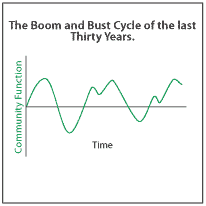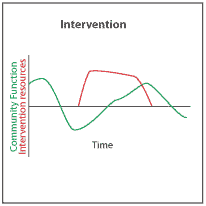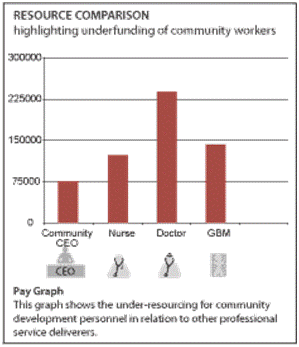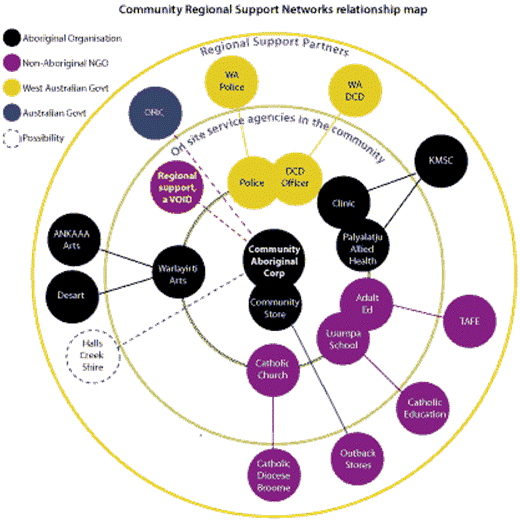Over the last thirty years there has been considerable success in areas particularly in housing and physical infrastructure. Twenty five years ago many Aboriginal people living on remote communities did not have a house. On a Community I was on in 1987 there were 8 houses for approximately 450, most families lived in corrugated iron 'wiltjas' (hand-made shade shelters) now that same community has about over 45 houses, it must be noted that it is still insufficient. They had much poorer access to many of the services that they now have. The general understanding of the western world and how it operates has also improved considerably, I'm not so sure if the western worlds' understanding of Aboriginal people has improved so much.
However; we still have a long way to go to 'close the gap'. The positives have often been under reported while the negative and sensational makes headlines. Many commentators point to the negatives and state that previous efforts at community development have failed, if in some areas this is so, why? From our experience we outline what we see as the main reasons for this failure;
- Lack of resources
- Lack of skilled community developers
- Community development is poorly understood
- Lack of a support network
- Service delivery or community development or both
1. Lack of skilled community developers
A major area that has been problematic is the attraction and retention of talented staff at a Community level. Poorly paid, partially qualified and semi-trained staff has resulted in high staff turn-over, poor outcomes and inefficient use of resources. This in results in inconsistent performance and what some term the 'boom and bust' cycle of community function, things go well while there is good governance and sound management following community development principles only to turn to dysfunction, if there is a management change for the worse.



Graphic 1; Community function over time.
The critical need for well paid, experienced and qualified staff has been acknowledged in the recruitment of NTER Government Business Managers (GBMs). The creation of these positions and the salaries they attract is recognition by the Government of the calibre of person required for such positions.
2. Lack of resources
It has been well researched and documented that Aboriginal communities have been significantly under resourced, this has been well researched by numerous experts including the Centre for Aboriginal Economic Policy Research (CAEPR).
The pay rates for the GBM positions are Government recognition of how under resourced Aboriginal communities have been in a general sense.

Graphic 2: Comparison of approximate pay rates for professionals on a Aboriginal Community.
Graph 2 illustrates pay rates of the 'old' community developer positions (CDO, MSO, CEO) compared to the pay for the 'Government Business Manager' GBM position and health professionals.
2. Community development is poorly understood
The principles of community development are not well understood or practiced in Australia compared to in international development circles, eg the International Institute for Environment and Development, UK. Community development has often been misinterpreted and written off as being soft or 'feel good' stuff instead of genuine practical development.
Community Development Principles include:
- Community Participation
- Community Ownership
- Empowerment and Accountability
- Lifelong Learning
- Long term commitment
- Inclusion
- Access and Equity
- Social Action
- Advocacy
- Networking
- Self Help
- Trust
The focus of training and study in Australia in recent times has been on Community or Aboriginal administration and service delivery rather than Community development. This and the shift in focus over the last 5 to 10 years to service delivery and physical development rather than holistic community development has been detrimental, both are essential.
3. Lack of a support network
A lack of regional support and mentoring using established community development principles for community development workers has characterised work throughout Australia in recent times. Our work in many communities highlighted this, our Balgo case study is one example 2. Most service deliverers on the community; the school, police, clinic, church, arts and store have a regional, state, national or even international support network, to assist with advice, administration, recruiting and professional development assistance and mentoring.
The Community Corporation is the exception, Wirrimanu Aboriginal Corporation (WAC) their directors and CEO had no-one. All our team have experienced this, when the 'going gets tough, you look over your shoulder, and there is ...... no-one, save the community, you and your wits.'

Graphic 3: On site agencies in Balgo, their relationships and their support networks.
The graphic above illustrates all on-site service agents and their regional support network, note that WAC has no such support mechanism, only the Office of the Registrar of Indigenous Corporations (ORIC) whose role is limited to regulating Corporations. This "isolated managerialism" can be overcome by regionalism that respects localism rather than disparages it.
Where there have been regional bodies providing community development and services to communities:
- There has been a disconnection between the regional bodies and communities in a structural sense, the Community often had little influence over what was done 'for or to the Communities'.
- There was no strong imperative or positive encouragement to utilise these services.
- Often the regional service providers come with a top down or 'we will develop your Community' approach rather than a genuine working together, and facilitation perspective. This can lead to resentment and to passive resistance or a decline in participation.
4 Service delivery , community development or both
Since 1994 there has been a conscious move away from community development to a predominately physical services delivery model. One example is the transfer of municipal services from the community corporations to shires which has consolidated this position. This may well improve service delivery but has resulted in community development being left 'off the agenda'.
The functions, roles and services Community Councils used to provide and that are recognised as being important but that have now 'slipped through the gap', broadly fall into the following categories:
- Whole of community governance; leadership, management, and coordination (as distinct from corporate governance, the communities' communications 'hub').
- Community development.
- Community and members services (the 'glue factor' or 'love jobs').
- Local corporate governance, management and administration.
The Government has recognised this, FaHCSIA have identified these as being important functions and categorised them slightly differently in their work on the 'glue' factor or those 'other things that hold a community together'.
- Functions that benefit the broader community.
- Functions that benefit individuals and families.
- Functions undertaken on behalf of government agencies, eg the coordination and communications 'hub' for community consultations.
- Basic services and supplies.
The void
These shifts in focus and in the NT's case the transition to the Shires leave a void that the Shire or mainstream service providers cannot fill. In our consultations and experience this is widely recognised as important but no one has carriage of responsibility or is resourced to 'fill the gap'.
Where to next? For the complete paper please download 'Sustainable Community Development Australia'
Rob Burdon 31st January 2009